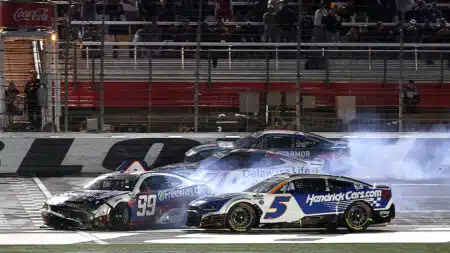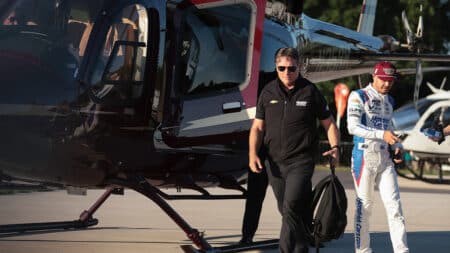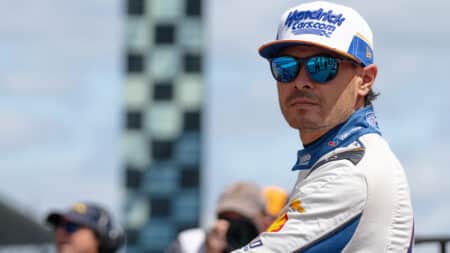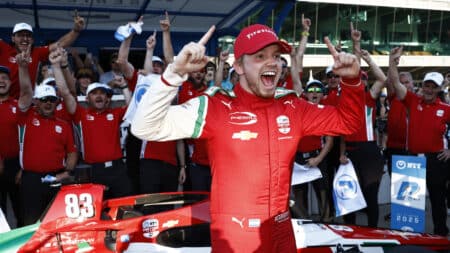
'Double isn't worth it', says Larson after 2025 attempt ends in disaster
Two crashes left Kyle Larson's hopes of completing the Indy 500 and Coca Cola 600 double in tatters — but did he even stand a chance in the first place?
Back in the day, long after his retirement as a driver, Vic Elford worked for years for Skip Barber’s racing drivers’ school at Sears Point in California, and very occasionally he came across a youngster in whom he saw exceptional promise.
“One day,” Elford said, “this gentleman from South America turned up with his tiny little kid. The man’s name was Pablo Montoya, and after three days of working with his kid I said to him, ‘Look after your boy, and if you do everything right he just could be World Champion.’ And I still think he should have been…”
Morris Nunn, who worked miracles with Ensign, his shoestring Formula 1 team, before setting off to seek a new life in the USA, was always of the same opinion. Nunn ultimately ran his own Indycar team, but first worked with great success for such as Chip Ganassi Racing.

Nazareth, 1999
It was at Ganassi that Nunn first encountered Juan Pablo Montoya, then spending a couple of years in Indycars preparatory to his F1 debut with Williams in 2001. I remember talking to Maurice about JPM before the start of their first season of working together: “In all my years in racing I’ve never seen anyone like this kid before. When we started testing on the ovals he was unbelievably quick, but I was sure he was set for a huge accident. I mean, you just don’t get a car sideways on an oval…
“I kept trying to slow him down, but nothing worked, and eventually I stopped worrying about it. Nothing fazed him, and I began to realise he really was that good, that confident. I knew he was only in CART for a limited time, before going to drive for Frank, and I thought for sure he was World Champion material.”
Prior to his couple of years in the States, Montoya had made a name for himself in Formula 3000 – indeed, Christian Horner cites a moment in testing at Estoril as the reason he himself gave up driving. “I came out of the pits, and accelerated towards the first corner. In those days, the first turn was an ultra-quick downhill right-hander, followed by another, and there wasn’t much in the way of run-off if you made a mistake.

Catalunya, 1998
“Anyway, as I got to the corner, Juan Pablo came past me, and he just made the two corners into one. Never lifted for an instant – you could see the tyres almost coming off the rims! I said to myself, ‘There’s no way I could everdo that…’”
Montoya’s two years in CART with Ganassi, 1999-2000, produced many victories and a championship. These were immensely quick cars, and one of his particular strengths was an ability – unmatched by any of his rivals – to go quickly on new tyres. Then, as now, tyre-warmers were not allowed in Indycar racing, and, having watched Juan Pablo cope with 900hp on cold tyres, I have to smile at the hysterical response in F1 whenever there is talk of banning tyre-warmers.
Although at the time of Montoya’s involvement Indycar racing was still split, with the Indianapolis 500 run to Indy Racing League rules, Ganassi’s team nevertheless participated at Indy in 2000, and JPM left everyone behind.

Indianapolis, 2000
Perhaps, when he came to F1 with Williams in ’01, expectations were unrealistically high, although in only his third race, at Interlagos, he gave notice of intent, stunning no less than Michael Schumacher with an overtaking move for the lead after a restart. Juan Pablo then led the bulk of the race before being punted out by a backmarker.
Thereafter, though, he had a string of disappointing races, with not a few accidents, and it wasn’t until the second half of the season that he began to show strongly again. Finally, at a sombre Monza – five days after September 11 – he took his first Grand Prix victory.
In subsequent seasons, six more followed, including one at Monaco, pressured relentlessly by the McLaren of Kimi Rӓikkӧnen. In 2003 JPM seriously challenged Schumacher for the World Championship, but by mid-season, following a falling-out with Sam Michael, had accepted Ron Dennis’s timely offer of a McLaren drive for 2005, following the conclusion of his Williams contract.

Hockenheim, 2003
Montoya’s very last drive for Williams, at Interlagos in ’04, brought another victory, again after a battle with Rӓikkӧnen. A year on, now with Kimi as his McLaren team mate, the result was the same.
Although it was one of three races that Juan Pablo won that year, he always felt like ‘the other driver’ at McLaren, and never really settled in. “I never knew where I was with Ron Dennis,” he said. “One day I’d play golf with him, and he was my friend. The next day I’d go to the factory, and he’d walk straight past me…”
By midseason in 2006 team and driver had had enough of each other, and Montoya told me that at that point he was on the verge of retiring. “When I left F1, I was so tired that I’d got to the point that I was going to quit racing. It wasn’t about going somewhere else… I didn’t want to race! Why was I doing it? I’d made enough money to retire. The only thing that would have kept me in F1 would have been a Ferrari drive – and there was no seat for me.

Monaco, 2006
“It was a shame, you know, because when you’re a kid growing up, your dream is always F1. And when you get there, at first you’re very naïve, so you don’t really see and understand everything – but with time you do. In F1, if you’re in the right car in the right year, you win races – if you’re not, you don’t. And if you’re in the right team, but you’re not the chosen driver, you’re not going to win much, either. Whether they admit it or not, in every F1 team there’s an ‘A’ driver and a ‘B’ driver – that’s the way it is, and if you’re not ‘The Man’, then you’re screwed. And it gets boring…
“Something I really hated, too, was the change from the V10s to the V8s – it was like going from an F3000 car to an F3 car. We lost 200 horsepower – and kept the same tyres, same chassis, same aero, same everything!”
What followed eventually was a call to his old pal Ganassi, and it wasn’t long before a deal was concluded. There was, however, no question of a return to Indycars: his future, he had decided, lay with NASCAR, but over the next eight seasons, while he was frequently on the pace, and once in a while dominated a race, there were only two victories, both of them on road courses.

Watkins Glen, 2010
I kept in touch with JPM over time, and always he was adamant that he loved the environment of NASCAR, and although it wasn’t easy to believe him, he insisted he had no regrets about leaving F1 behind. “In NASCAR, whether you’re running first or 30th, you’re always in a race, and I love that…”
Well, yes, but Ganassi’s NASCAR outfit has never been a match for his IndyCar team, and the lack of results disappointed both Chip and his driver. Last year Montoya was informed that his contract would not be renewed for 2014.
What now? When an offer came from Roger Penske to return to Indycars, Juan Pablo was only too happy to say yes, and there were those who believed he would swiftly pick up where he had left off.
Others, though, struck a cautionary note. Dario Franchitti, another Ganassi stalwart, has always got long well with Montoya, and knows him of old: in 1999 the pair of them finished the season on equal points, JPM taking the championship by virtue of more victories.
“I think it might take Juan Pablo a bit longer to settle into Indycars again than some people are suggesting,” Dario told me.

Long Beach, 1999
“Back in ’07 I won Indy and the championship, but I had two huge shunts, and thought, ‘OK, I need to do something else…’ I had to get away from Indycars at that time – I was just worn out. I thought my future was going to be NASCAR, but sometimes, when you do something a lot, you don’t realise how good it is until you step back from it…”
After a single season of NASCAR, which he did not greatly enjoy, Franchitti decided on a return to Indycars with Ganassi. “I’ll tell you what, though, the first time I got back in one – in a test at Texas – I came in after about five laps, and my eyes were this big! I said, ‘Has this thing got more power than it had in ’07?’ They said no. I said, ‘Am I sitting further back than I was?’ They said no, exactly the same. ‘Same downforce as before?’ Yep. I said, ‘Well, I really don’t remember them being this fast…’
“Now, I felt that after one season away, driving stock cars. Juan Pablo’s been away from single-seaters for eight years. I’m sure he can do it, but I very much doubt it’s going to be instant…”

Franchitti, and others, have been proved right. Now 38, Montoya appeared to struggle in this season’s early races, and inevitably some IndyCar insiders said that it was the consequence of ‘driving taxicabs’ for too long, while others more charitably suggested it was inevitably going to take a while to ‘get the rust off’.
When I saw Juan Pablo at Indianapolis, he was all smiles, and said how much he was enjoying life with Penske. Yes, it was taking time to readjust to single-seaters, but he had expected that, and he felt that everything was beginning to come back.
Certainly it looked that way in the 500, and had it not been for a ‘drive through’ penalty (for speeding in the pitlane) in the late stages, he would have been well in the mix during the final laps. As it was, he finished fifth, and a couple of weeks ago, was second in one of the races at the Houston street circuit. Perhaps more importantly, Montoya showed real signs of his old combative self, and one hoped it was the beginning of an IndyCar renaissance.

Maybe it was. Last weekend, at Pocono, JPM went one better, taking pole position, then scoring his first win in a single-seater since that victory for McLaren at Interlagos back in October 2005.
To this day I think Juan Pablo a great loss to Grand Prix racing, and as I watched him over the years running mid-pack in countless NASCAR races I could only regret the absence of his ability and mercurial personality from the World Championship. Perhaps Elford and Nunn were right in their assessment of him, perhaps not, but I’ll always wish we could have seen the best of Montoya in F1.

Two crashes left Kyle Larson's hopes of completing the Indy 500 and Coca Cola 600 double in tatters — but did he even stand a chance in the first place?

The crunch point of Kyle Larson's Indy 500 and Coca Cola 600 double bid will come as he races from Indianapolis to Charlotte in a complex procedure involving cars, helicopters and planes. Ryan Glenn will be co-ordinating it... by text message

Kyle Larson will once again attempt the double this weekend. He explains his plans to complete the Indy 500 and NASCAR's Coca-Cola 600 in one day and overcome the "PTSD" of last year's bid

Robert Shwartzman and Prema stunned the field by claiming pole position for the 2025 Indianapolis 500 in his first-ever oval race. Here's a look at how they pulled it off